Safeguarding sensitive data and ensuring the integrity of information systems is paramount for businesses in today’s world. SOC 2 compliance has emerged as a critical framework for organizations entrusted with the data of their customers and stakeholders. This comprehensive guide aims to demystify SOC 2 compliance, outlining its principles, requirements, and significance in today's business environment.
What Is SOC 2?
SOC 2, short for Service Organization Control 2, is a framework developed by the American Institute of Certified Public Accountants (AICPA). It focuses on the controls and processes necessary to secure and protect customer data stored in the cloud and other technology-based services. Unlike SOC 1, which evaluates controls relevant to financial reporting, SOC 2 specifically addresses the security, availability, processing integrity, confidentiality, and privacy of data.
What Is SOC 2 Compliance?
SOC 2 compliance refers to an organization's adherence to the trust service criteria outlined in the SOC 2 framework. Achieving SOC 2 compliance demonstrates that an organization has implemented effective controls and processes to ensure the security, availability, processing integrity, confidentiality, and privacy of customer data.
SOC 2 Compliance Requirements
To achieve SOC 2 compliance, organizations must meet the requirements outlined in the SOC 2 framework. These requirements include:
Establishing and maintaining a secure infrastructure to protect against unauthorized access, data breaches, and other security threats.
Implementing measures to ensure the confidentiality of customer data, including encryption, access controls, and data masking techniques.
Ensuring the availability of systems and services to meet the needs of customers and stakeholders, including measures to prevent and mitigate downtime.
Safeguarding the privacy of customer information by adhering to applicable laws, regulations, and industry best practices.
Maintaining the integrity of data processing operations, including accuracy, completeness, and timeliness of data.
SOC 2 Certification: The 5 Trust Principles
There are five trust principles that serve as the foundation for SOC 2 audits, each focusing on different aspects of data security, privacy, and integrity:
Security
The security principle requires organizations to implement measures to protect against unauthorized access, both physical and logical, to their systems and data. This involves safeguarding infrastructure, software, and information assets against potential threats such as hacking, data breaches, and misuse.
Confidentiality
Confidentiality focuses on protecting sensitive information from unauthorized disclosure. Organizations must implement controls to ensure that confidential data is accessed only by authorized individuals and is protected against unauthorized access, disclosure, or misuse.
Availability
This principle emphasizes ensuring that services are available for operation and use as agreed upon with clients. It involves maintaining high uptime levels, minimizing downtime, and implementing disaster recovery plans to mitigate the impact of disruptions or outages.
Privacy
The privacy principle requires organizations to handle personal information in accordance with relevant privacy laws, regulations, and contractual agreements. This involves establishing and maintaining processes to collect, use, disclose, and dispose of personal data in a manner that respects individual privacy rights and expectations.
Processing Integrity
Processing integrity pertains to the accuracy, completeness, and reliability of data processing. Organizations must ensure that their systems operate correctly, processing data accurately and promptly, without any unauthorized alterations or errors.
SOC 2 Type 1 vs Type 2
There are two types of SOC 2 reports: Type 1 and Type 2. A SOC 2 Type 1 report evaluates an organization's controls and processes at a specific point in time, providing a snapshot of compliance. In contrast, a SOC 2 Type 2 report assesses the effectiveness of controls over a specified period, typically six months to a year, providing a more comprehensive view of compliance over time.
SOC 1 vs SOC 2 vs SOC 3
It's important to distinguish between SOC 1, SOC 2, and SOC 3 reports. SOC 1 reports focus on controls relevant to financial reporting, while SOC 2 reports address controls related to security, availability, processing integrity, confidentiality, and privacy. SOC 3 reports, also known as SOC for Service Organizations: Trust Services Criteria for General Use Report, provide a summary of an organization's SOC 2 compliance in a publicly available format.
The Importance of SOC 2 Compliance
Achieving SOC 2 compliance is essential for organizations that handle sensitive customer data or provide services that impact the security and privacy of their clients. Compliance not only demonstrates a commitment to data security and privacy but also enhances trust and credibility with customers, partners, and regulators. Additionally, SOC 2 compliance can help organizations mitigate the risk of data breaches, avoid costly fines and penalties, and safeguard their reputation.
Achieve SOC 2 Compliance with Xamin
Xamin offers comprehensive solutions to help organizations achieve and maintain SOC 2 compliance. With our expertise in cybersecurity, risk management, and regulatory compliance, we can assess your current controls, identify gaps, and develop a tailored compliance roadmap.
Contact us today to learn more about how Xamin can support your SOC 2 compliance efforts and ensure the security and integrity of your data.


